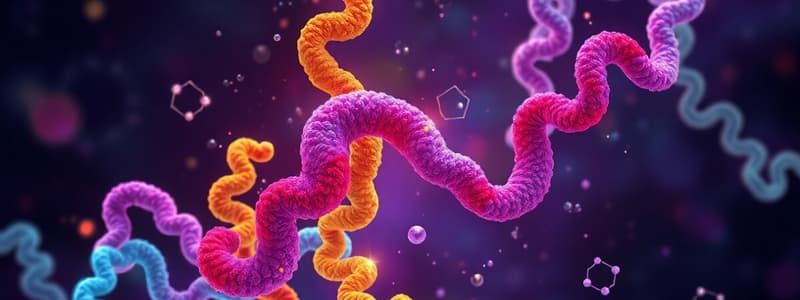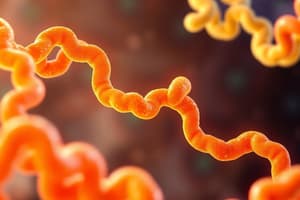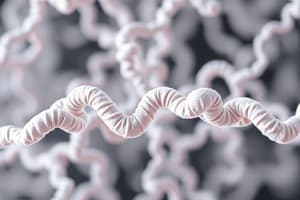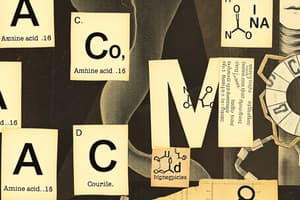Podcast
Questions and Answers
Amino acids are classified into six main classes based on their R groups.
Amino acids are classified into six main classes based on their R groups.
False (B)
All non-polar aliphatic amino acids have a branched chain structure.
All non-polar aliphatic amino acids have a branched chain structure.
False (B)
The R group of an amino acid can affect its solubility in water.
The R group of an amino acid can affect its solubility in water.
True (A)
Histidine is classified as a non-essential amino acid.
Histidine is classified as a non-essential amino acid.
Glutamine is classified as a non-essential amino acid.
Glutamine is classified as a non-essential amino acid.
Aspartate is a polar, negatively charged amino acid.
Aspartate is a polar, negatively charged amino acid.
There are 10 essential amino acids that the human body cannot synthesize.
There are 10 essential amino acids that the human body cannot synthesize.
Phenylalanine is an aromatic amino acid.
Phenylalanine is an aromatic amino acid.
Glucogenic amino acids can be converted into glucose during metabolism.
Glucogenic amino acids can be converted into glucose during metabolism.
Glucogenic amino acids are catabolised to pyruvate, α-ketoglutarate, succinyl CoA, fumarate or oxaloacetate while ketogenic amino acids produce glucose.
Glucogenic amino acids are catabolised to pyruvate, α-ketoglutarate, succinyl CoA, fumarate or oxaloacetate while ketogenic amino acids produce glucose.
Both glucogenic and ketogenic amino acids can result in the formation of fat or ketone bodies.
Both glucogenic and ketogenic amino acids can result in the formation of fat or ketone bodies.
Alanine is classified as a glucogenic amino acid.
Alanine is classified as a glucogenic amino acid.
Phenylalanine is exclusively a glucogenic amino acid.
Phenylalanine is exclusively a glucogenic amino acid.
Lysine can be classified as a glucogenic amino acid.
Lysine can be classified as a glucogenic amino acid.
4-hydroxyproline is an example of a common amino acid modification found in collagen.
4-hydroxyproline is an example of a common amino acid modification found in collagen.
Non-protein amino acids are found in cells but not in proteins.
Non-protein amino acids are found in cells but not in proteins.
Tryptophan is a glucogenic amino acid.
Tryptophan is a glucogenic amino acid.
Glutamate is only classified as a ketogenic amino acid.
Glutamate is only classified as a ketogenic amino acid.
The degradation of amino acids leads only to seven common metabolic intermediates.
The degradation of amino acids leads only to seven common metabolic intermediates.
Infants born with a complete deficiency of urea synthesizing enzymes can survive after their first protein meal.
Infants born with a complete deficiency of urea synthesizing enzymes can survive after their first protein meal.
Citrullinemia is characterized by elevated levels of citrulline in plasma and cerebrospinal fluid.
Citrullinemia is characterized by elevated levels of citrulline in plasma and cerebrospinal fluid.
Patients with inherited defects in urea synthesizing enzymes can tolerate protein-rich diets without concerns.
Patients with inherited defects in urea synthesizing enzymes can tolerate protein-rich diets without concerns.
Hyperammonemia Type 2 is an X chromosome-linked deficiency caused by ornithine transcarbamoylase deficiency.
Hyperammonemia Type 2 is an X chromosome-linked deficiency caused by ornithine transcarbamoylase deficiency.
The first approach to treatment for urea cycle disorders includes a high protein intake.
The first approach to treatment for urea cycle disorders includes a high protein intake.
Argininosuccinic aciduria is characterized by low levels of argininosuccinate in blood, cerebrospinal fluid, and urine.
Argininosuccinic aciduria is characterized by low levels of argininosuccinate in blood, cerebrospinal fluid, and urine.
Ornithine and citrulline are products of the urea cycle.
Ornithine and citrulline are products of the urea cycle.
The average adult body contains approximately 100 kg of body protein.
The average adult body contains approximately 100 kg of body protein.
Amino acids can only be synthesized from dietary protein.
Amino acids can only be synthesized from dietary protein.
The daily protein breakdown in adults is estimated at 300-400 g.
The daily protein breakdown in adults is estimated at 300-400 g.
Histamine is produced by the decarboxylation of glutamate.
Histamine is produced by the decarboxylation of glutamate.
Energy accounts for 10-15% of the body’s daily requirement from protein metabolism.
Energy accounts for 10-15% of the body’s daily requirement from protein metabolism.
Decarboxylation reactions convert amino acids into carbohydrates.
Decarboxylation reactions convert amino acids into carbohydrates.
Histidine decarboxylase requires vitamin B6 as a coenzyme.
Histidine decarboxylase requires vitamin B6 as a coenzyme.
Non-essential amino acids are synthesized mainly from dietary protein.
Non-essential amino acids are synthesized mainly from dietary protein.
The body loses approximately 30-50 g of protein daily through various processes.
The body loses approximately 30-50 g of protein daily through various processes.
Citrulline condenses with aspartate to form argininosuccinate in the mitochondria.
Citrulline condenses with aspartate to form argininosuccinate in the mitochondria.
The synthesis of argininosuccinate consumes one ATP and is catalyzed by argininosuccinate synthetase.
The synthesis of argininosuccinate consumes one ATP and is catalyzed by argininosuccinate synthetase.
Ornithine is regenerated during the cleavage of arginine by arginase.
Ornithine is regenerated during the cleavage of arginine by arginase.
The overall urea cycle reaction is reversible and consumes 4 ATP.
The overall urea cycle reaction is reversible and consumes 4 ATP.
Fumarate is produced during the argininosuccinate lyase reaction and enters the urea cycle.
Fumarate is produced during the argininosuccinate lyase reaction and enters the urea cycle.
ATP generated in the TCA cycle is utilized for urea synthesis.
ATP generated in the TCA cycle is utilized for urea synthesis.
Hyperammonaemia can result from defects in any one of the five enzymes involved in urea synthesis.
Hyperammonaemia can result from defects in any one of the five enzymes involved in urea synthesis.
Oxaloacetate can be formed from fumarate in the mitochondria.
Oxaloacetate can be formed from fumarate in the mitochondria.
The urea cycle does not involve any interactions with the citric acid cycle.
The urea cycle does not involve any interactions with the citric acid cycle.
The TCA cycle utilizes CO2 produced during the urea cycle.
The TCA cycle utilizes CO2 produced during the urea cycle.
Flashcards are hidden until you start studying
Study Notes
Amino Acid Classification
- Amino acids differ based on their R group, which influences their structure, size, and electrical charge.
- The R group also affects the amino acid's solubility in water.
- Five classes of amino acids exist:
- Non-Polar Aliphatic
- Aromatic
- Polar, Uncharged
- Polar, Positively Charged
- Polar, Negatively Charged
Non-Polar Aliphatic Amino Acids
- Glycine (Gly, G)
- Alanine (Ala, A)
- Proline (Pro, P)
- Valine (Val, V) Branched Chain
- Leucine (Leu, L) Branched Chain
- Isoleucine (Ile, I) Branched Chain
- Methionine (Met, M)
Aromatic Amino Acids
- Phenylalanine (Phe, F)
- Tyrosine (Tyr, Y)
- Tryptophan (Trp, W)
Polar, Uncharged Amino Acids
- Serine (Ser, S)
- Threonine (Thr, T)
- Cysteine (Cys, C)
- Asparagine (Asn, N)
- Glutamine (Gln, Q)
Polar, Positively Charged Amino Acids
- Lysine (Lys, K)
- Arginine (Arg, R)
- Histidine (His, H)
Polar, Negatively Charged Amino Acids
- Aspartate (Asp, D)
- Glutamate (Glu, E)
Nutritional Classification
- Essential amino acids cannot be synthesized by the human body and must be obtained through diet.
- Non-essential amino acids can be synthesized by the body.
Metabolic Classification
- Amino acids are categorized based on their metabolic intermediates produced during catabolism.
- Glucogenic amino acids are catabolized to pyruvate, α-ketoglutarate, succinyl CoA, fumarate, or oxaloacetate, which can form glucose.
- Ketogenic amino acids are catabolized to acetyl CoA or acetoacetate, which can form fat or ketone bodies.
Uncommon Amino Acids
- Aside from the 20 common amino acids, uncommon amino acids are found in small amounts in proteins and non-protein compounds.
- These unusual amino acids are often modifications of common amino acids – derived amino acids.
- Some examples include 4-hydroxyproline and 5-hydroxylysine found in collagen, and 6-N-methyllysine found in myosin.
Non-Protein Amino Acids
- Some amino acids are found in cells but not in proteins.
- Ornithine and citrulline are examples, acting as intermediates in arginine biosynthesis and the urea cycle.
Amino Acid Pool
- The body contains a pool of ~100g of amino acids.
- This pool is maintained through dietary intake, protein breakdown, and synthesis.
- Amino acids are utilized for protein synthesis, non-protein compound synthesis, and energy production (10-15% of daily requirements).
- Excess dietary protein is converted to carbohydrates and fat.
General Reactions of Amino Acids
- Amino acids undergo various reactions, including decarboxylation, transamination, and deamination (oxidative and non-oxidative).
Decarboxylation Reaction
- Amino acids are decarboxylated to form amines.
- Histidine is decarboxylated to histamine by histidine decarboxylase, requiring pyridoxal phosphate as a coenzyme.
Histamine
- Histamine is involved in various physiological roles, including gastric acid secretion and neurotransmission.
Urea Synthesis (Urea Cycle)
- The urea cycle is a metabolic pathway that removes ammonia from the body.
- Step III: Synthesis of argininosuccinate: Citrulline condenses with aspartate to form argininosuccinate, catalyzed by argininosuccinate synthetase. Requires one ATP.
- Step IV: Cleavage of argininosuccinate: Argininosuccinate is cleaved into fumarate and arginine by argininosuccinate lyase.
- Step V: Formation of urea: Arginine is cleaved by arginase to yield urea and ornithine.
Overall Urea Cycle Reaction
- The cycle is irreversible and consumes 4 ATP.
- NH4+ + CO2 + Aspartate + 3 ATP → Urea + Fumarate + 2 ADP + 2 Pi + AMP + PPi
Link Between Ornithine/Urea and Citric Acid Cycles
- The two cycles are linked in several ways:
- Fumarate produced in the urea cycle is transported to the mitochondria and ultimately converted to oxaloacetate.
- Oxaloacetate can be used in the TCA cycle, gluconeogenesis, or transamination to aspartate, which is a nitrogen donor in the urea cycle.
- CO2 liberated from the TCA in mitochondria is used in the urea cycle.
- The TCA cycle generates 12 ATP, while the urea cycle consumes 4 ATP.
Inherited Enzymatic Defects of the Urea Cycle
- Defects in any of the five enzymes in the urea cycle lead to hyperammonemia.
- Symptoms include lethargy, stupor, convulsions, CNS impairment, and, in severe cases, coma and death.
- Infants with complete deficiencies in urea synthesizing enzymes die shortly after their first protein meal.
- Partial deficiencies may allow survival into adulthood if managed properly.
- Patients with deficiencies require low-protein diets and may benefit from α-keto analogues of essential amino acids.
- Hyperammonemia Type 1: Carbamoyl phosphate synthase I deficiency.
- Hyperammonemia Type 2: Ornithine transcarbamoylase deficiency (X-linked).
- Citrullinuria/Citrullinemia: Argininosuccinate synthetase deficiency.
- Argininosuccinic aciduria/acidemia: Argininosuccinase deficiency.
- Hyperargininemia: Arginase deficiency.
Treatment of Urea Cycle Defects
- Low protein diets are essential.
- Avoid prolonged fasting.
- α-keto analogues of essential amino acids can be provided.
Studying That Suits You
Use AI to generate personalized quizzes and flashcards to suit your learning preferences.




